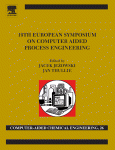Au thors: Ricardo MORALES-RODRIGUEZ and Rafiql GANI
thors: Ricardo MORALES-RODRIGUEZ and Rafiql GANI
Affiliation: CAPEC, Department of Chemical and Biochemical Engineering, Technical University of Denmark, DK-2800 Lyngby, Denmark
Reference: Computer Aided Chemical Engineering, Volume 26, 2009, pp. 495–500. Edited by Jacek Jeżowski and Jan Thullie
Abstract
The design, development and reliability of a chemical product and the process to manufacture it, need to be consistent with the end-use characteristics of the desired product. One of the common ways to match the desired product-process characteristics is through trial and error based experiments which can be expensive and time consuming. An alternative approach is the use of a systematic model-based framework according to an established work-flow in product-process design, replacing some of the time consuming and/or repetitive experimental steps. Furthermore, for many chemical products the appropriate models for product-process design need to have multiscale features as the properties defining the chemical structure and the product end-use characteristics are dependent on parameters of different size and time scales. The advantages of the use of multiscale modelling approach in this case is that in the design, development and/or manufacturing of a product-process, the knowledge of the applied phenomena can be provided at diverse degrees of abstractions and details.
The development of a computer-aided framework for product-process design including a multiscale modelling option is very important for analysis, design, and/or identification of feasible chemical product candidates because it allows one to consider processing issues during the development of the product. The multiscale modelling framework should include the product and process design components, modelling tools and templates (work-flow) for guiding the user through the appropriate design steps. The integration of computational tools is also necessary to increase the application range of the computer-aided product-process framework; where the connection between computational tools could be established through well-defined COM-objects or the CAPE-OPEN standards.The objective of this paper is to present a novel computer-aided model-based framework for product-process design that also includes multiscale modelling features. To develop this framework, a combination of different computational tools, such as, property prediction packages, modelling tools, simulation engines, solvent selection software, etc, are necessary together with a set of established systematic work-flow and data-flow for various types of design problems. This framework allows the user to cover a wide range of problems at different scales (of length and time) and disciplines of chemical engineering and science in an easy and efficient manner; achieving in this way the development of a product-process with the desired end-use characteristics. Development of a pesticide formulation product where its uptake into the plant is used as a product performance measure, is used to highlight the work-flow and data-flow in the multiscale modelling framework.
